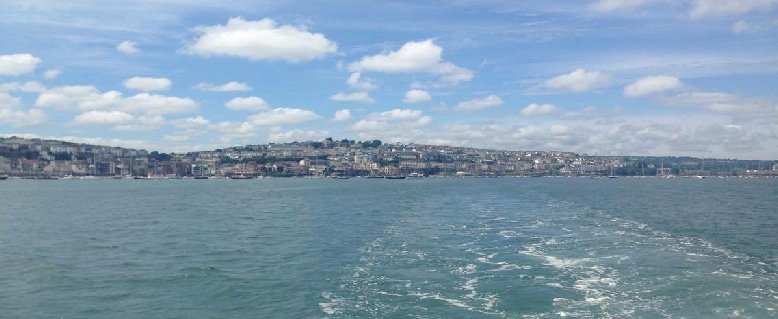
All references on this page can be found on the poster.
The views expressed on this website are not those of the University of Southampton or the National Oceanography Centre Southampton
Habitat mapping of Falmouth Bay

Ecosystem services
Calcifying reefs such as the coralline algae Lithothamnion carallioides (Maerl) can provide valuable ecosystem services to an environment, often by providing a habitat for benthic species to live amongst. Maerl beds can be of importance to sustainable fisheries, providing nursery grounds for commercial species of fish and shellfish (4). It has been shown that the ratio of live to dead maerl in an environment has an impact on the abundance and diversity of taxa present; in Falmouth mixed maerl beds (consisting of both live and dead fragments) supported a greater number of of taxa and abundance that homogeneously dead beds, however in Jersey mixed and dead bed supported a similar number of taxa, while dead beds had a greater abundance of epifauna (3).
The benthic habitat of Falmouth Bay was mapped using side scan sonar and underwater videography to determine the sediment type, bed formation and dominant species in the area, the poster below summarises the main findings from the area surveyed.
Introduction
Falmouth Bay is located in Cornwall, Southwest England. This area is a designated Special Area of Conservation (SAC) site and consequently it is important to map the benthic habitat of the area.
The survey took place on the MTS Xplorer on the 23rd of June 2016 between 11:00 and 14:30 GMT. Cloud cover was 2/8 and the sea was calm. Low tide was at 14:21 GMT. Four transects were covered in the yellow area (see poster), just off Gylly Beach, at roughly 50.139° N, 5.049° W. The third transect was not completely straight since there was a vessel that had to be avoided.
The aim was to produce a habitat map of the area and establish how the distribution of species is related to the changes in the seafloor topography, the prevailing physics and meteorology.
As well as its economic importance, Falmouth Bay is important for the scientific community since it is home to rare species such as maerl and eel grass, which create very interesting environments to study. Changes in these habitats could have a great impact in water quality and ecosystem services.
Methods
Four side scan transects were taken by a tow fish deployed from the back of the boat. The sonar layback was 16.7m. Offline measurements were displayed on a bar for the skipper to ensure that the transects were straight, however, transect 3 was forced offline at 13:22 when a boat was anchored on the transect. The start and end times and the positions in eastings and northings were noted for each transect. Eastings and northings OSGB36 were converted from Lat/Long to minimise distortion. Underwater videography was used to image the seafloor. The boat was positioned to drift across the transects as the camera was recording.
The side scan survey was later printed and aligned as a mosaic in order to view the seabed surveyed as a whole; the bedforms seen were asymmetric and there was little bifurcation, suggesting they were formed by water currents rather than wave action. Boundaries were determined from the size of the bedforms and the substrate, resulting in areas of large ripples, small ripples, sand and rocks being identified. Slant range corrections were taken for the boundaries so that the true distance could be found from the ship track. Wavelengths and height measurements were calculated at positions where different sized bedforms could be identified. These were used in conjunction with Sam Boggs’ table to classify the bedforms, assuming unidirectional flow. The height of the rocks were also calculated.
Observations
The side scan showed a homogenous seabed at this location. The bedforms were deduced to be straight transverse sand waves using the classification system of Sam Boggs (2). In Zone 2 (orange) the bedforms are considerably smaller (wavelength <1, height approximately 30 cm). This was evidenced in the video transect over Zones 1 and 2. It also coincided with the appearance of the brittle stars shortly after entering Zone 1. Zone 3 (pink) was a dark patch on the side scan with higher backscatter, suggesting that it was coarser material such as rock, however no video transect was conducted in this area. The rocks were calculated to be between 0.4 and 1 metres high. Zone 4 (blue) presented fewer shadows on the side scan with barely any bedforms, although there was little evidence of this on the video footage.
In both transects the most dominant organisms found were the brittle stars Ophiocomina nigra and Ophiothrix fragilis. Other species identified were the common star fish Asterias rubens, the coralline algae Lithothamnion carallioides, and one spotted ray (Raja montagui). The first video transect showed vast numbers of O. nigra filter feeding by raising their arms. Dense populations can result from pseudocopulation, a behaviour exhibited by both species which are known to breed in summer around Britain.
Throughout both transects the bed forms and sediment composition were homogenous, contrastingly the distribution of benthic echinoderms varied between the two transects. The seabed was composed mainly of broken shell which is likely due to the high wave energy of Falmouth Bay as it is not protected from South and Southeasterly weather (8). Furthermore, Falmouth Bay has experienced high wind speeds (up to 63km/h) in the recent months of April and May (9) and this may have broken up existing shells or swept it into the bay from elsewhere. The video also showed the troughs of the bedforms to have trapped larger pieces of organic, marine debris implying that they were formed at least a few months ago. This coincides with the larger wind speeds recorded during April and May and therefore it could be inferred that the sand waves formed around this time.